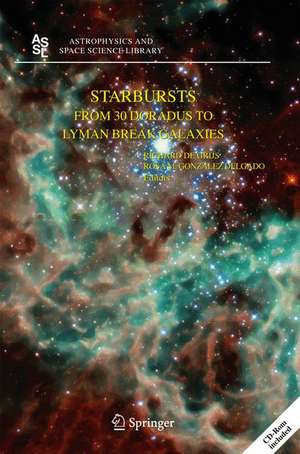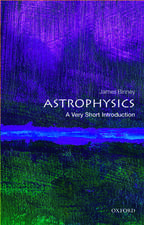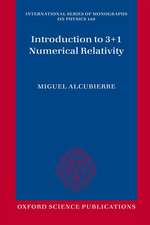Starbursts: From 30 Doradus to Lyman Break Galaxies: Astrophysics and Space Science Library, cartea 329
Editat de Richard de Grijs, Rosa M. González Delgadoen Limba Engleză Mixed media product – 9 iun 2005
Din seria Astrophysics and Space Science Library
- 24%
 Preț: 799.08 lei
Preț: 799.08 lei - 15%
 Preț: 647.92 lei
Preț: 647.92 lei - 18%
 Preț: 983.81 lei
Preț: 983.81 lei - 18%
 Preț: 790.28 lei
Preț: 790.28 lei -
 Preț: 359.85 lei
Preț: 359.85 lei -
 Preț: 389.70 lei
Preț: 389.70 lei - 20%
 Preț: 691.13 lei
Preț: 691.13 lei - 18%
 Preț: 1011.27 lei
Preț: 1011.27 lei -
 Preț: 402.56 lei
Preț: 402.56 lei - 15%
 Preț: 664.93 lei
Preț: 664.93 lei -
 Preț: 398.15 lei
Preț: 398.15 lei - 18%
 Preț: 954.77 lei
Preț: 954.77 lei -
 Preț: 411.04 lei
Preț: 411.04 lei - 18%
 Preț: 1225.31 lei
Preț: 1225.31 lei - 18%
 Preț: 1843.29 lei
Preț: 1843.29 lei -
 Preț: 393.13 lei
Preț: 393.13 lei -
 Preț: 400.26 lei
Preț: 400.26 lei - 18%
 Preț: 953.82 lei
Preț: 953.82 lei - 18%
 Preț: 960.61 lei
Preț: 960.61 lei -
 Preț: 398.35 lei
Preț: 398.35 lei -
 Preț: 390.84 lei
Preț: 390.84 lei -
 Preț: 413.76 lei
Preț: 413.76 lei -
 Preț: 416.64 lei
Preț: 416.64 lei - 18%
 Preț: 947.67 lei
Preț: 947.67 lei -
 Preț: 404.51 lei
Preț: 404.51 lei - 18%
 Preț: 956.50 lei
Preț: 956.50 lei -
 Preț: 403.75 lei
Preț: 403.75 lei - 18%
 Preț: 1229.40 lei
Preț: 1229.40 lei - 18%
 Preț: 1224.99 lei
Preț: 1224.99 lei -
 Preț: 404.29 lei
Preț: 404.29 lei - 15%
 Preț: 654.77 lei
Preț: 654.77 lei - 18%
 Preț: 1248.20 lei
Preț: 1248.20 lei - 18%
 Preț: 955.25 lei
Preț: 955.25 lei - 18%
 Preț: 1846.28 lei
Preț: 1846.28 lei - 18%
 Preț: 1233.06 lei
Preț: 1233.06 lei - 18%
 Preț: 1234.77 lei
Preț: 1234.77 lei -
 Preț: 411.64 lei
Preț: 411.64 lei
Preț: 1231.47 lei
Preț vechi: 1501.79 lei
-18% Nou
Puncte Express: 1847
Preț estimativ în valută:
235.67€ • 245.73$ • 195.86£
235.67€ • 245.73$ • 195.86£
Carte tipărită la comandă
Livrare economică 20 martie-03 aprilie
Preluare comenzi: 021 569.72.76
Specificații
ISBN-13: 9781402035388
ISBN-10: 1402035381
Pagini: 382
Ilustrații: XXVIII, 362 p. With CD-ROM.
Dimensiuni: 155 x 235 x 25 mm
Greutate: 0.84 kg
Ediția:2005
Editura: SPRINGER NETHERLANDS
Colecția Springer
Seria Astrophysics and Space Science Library
Locul publicării:Dordrecht, Netherlands
ISBN-10: 1402035381
Pagini: 382
Ilustrații: XXVIII, 362 p. With CD-ROM.
Dimensiuni: 155 x 235 x 25 mm
Greutate: 0.84 kg
Ediția:2005
Editura: SPRINGER NETHERLANDS
Colecția Springer
Seria Astrophysics and Space Science Library
Locul publicării:Dordrecht, Netherlands
Public țintă
ResearchCuprins
Local Starbursts as Benchmarks for Galaxy Evolution.- Local Starbursts in a Cosmological Context.- Starbursts in the Evolving Universe: A Local Perspective.- Are There Local Analogs of Lyman Break Galaxies?.- The Disk Wolf-Rayet Population of the Nuclear Starburst Galaxy M83.- Laser Illuminates Compact Galaxies.- First Spectroscopic Results from the Spitzer Infrared Nearby Galaxies Survey.- Near-IR Super Star Clusters in Starburst and Luminous Infrared Galaxies.- High-Resolution Imaging of the SSCs in NGC 1569 and NGC 1705.- Massive Star Clusters, Feedback, and Superwinds.- 30 Doradus — A Template for “Real Starbursts”?.- The Initial Mass Function in Starburst Regions: Environmental Dependences?.- The Initial Mass Function in Starbursts.- Dynamical Models of Star Formation and the Initial Mass Function.- Red Supergiants, Mass Segregation and M/L Ratios in Young Star Clusters.- IMF Variation in M82 Super Star Clusters.- Starbursts as a Function of Wavelength.- Colourful Starbursts.- A Far-Ultraviolet View of Starburst Galaxies.- Local Starbursts: Perspectives from the Optical.- The Starburst Phenomenon from the Optical/Near-IR Perspective.- Dissecting Starburst Galaxies with Infrared Observations.- What Fraction of Stars Formed in Infrared Galaxies at High Redshift?.- Shades: The Scuba Half Degree Extragalactic Survey.- Compact Extragalactic Star Formation: Peering through the Dust at Centimeter Wavelengths.- Dust Attenuation and Star Formation in the Nearby Universe: The Ultraviolet and Far-Infrared Points of View.- Theoretical Pan-Spectral Energy Distributions of Starburst Galaxies.- Triggering and Quenching of Starbursts and the Effects of Galactic Interactions.- Merger-Induced Starbursts.- Galaxy Collisions: Modeling Star Formation in Different Environments.-Star and Cluster Formation in Extreme Environments.- The Recurrent Nature of Central Starbursts.- Efficiency of the Dynamical Mechanism.- 2D Kinematics and Mass Derivations in ULIRGs.- Internal Kinematics of Luminous Compact Blue Galaxies.- Fuelling Starbursts and Nuclear Rings.- Star-Formation Rates in Relation to the Host Galaxy Properties.- Demographics and Host Galaxies of Starbursts.- Star-Forming, Recently Star-Forming, and “Red and Dead” Galaxies at 1 Z < 2.- Global Star-Formation Rates.- Star Formation Efficiencies and Star Cluster Formation.- Star Cluster Populations in Nearby Starburst Galaxies.- Young Massive Clusters in Non-Interacting Galaxies.- Nascent Starbursts in Synchrotron-Deficient Galaxies.- HST/STIS Spectroscopy of the Starburst Core of M82.- Starburst Tracers: Gas, Dust and Star Formation.- Starburst Galaxies: An Infrared Perspective.- Dusty Starbursts as a Standard Phase in Galaxy Evolution.- Is the Interstellar Gas of Starburst Galaxies Well Mixed?.- Star Clusters in M51: Connection between Molecular Gas, Stars and Dust.- Starbursts at Intermediate Redshifts and the Starburst versus AGN Paradigm.- Starbursts in Nearby Radio Galaxies.- Starbursts in Low Luminosity Active Galactic Nuclei.- GALEX Ultraviolet Spectroscopy of Luminous Infrared Galaxies.- A Recent Rebuilding of Most Spirals?.- Evolution of the IR Energy Density and SFH up to Z ? 1: First Results from MIPS.- Violent Star Formation and the Properties of Star-Forming Galaxies at High Redshift.- Understanding Infrared—Luminous Starbursts in Distant Galaxies.- Starbursts in the Ultra Deep Field.- Properties of Ly? and Gamma Ray Burst-Selected Starbursts at High Redshifts.- The Stellar Population of High-Z Galaxies from Medium-Resolution Spectra in the FORS Deep Field.-Star-Forming Galaxies at Z ? 2: Stellar and Dynamical Masses.- Metallicity of Star-Forming Galaxies.- New Metallicity Diagnostics for High-Redshift Star-Forming Galaxies.- UV Luminosity Function at Z ? 4, 3, and 2.- Massive Galaxies at Z = 2 in Cosmological Hydrodynamic Simulations.- K-Luminous Galaxies at Z ? 2.- Resolved Molecular Gas Emission in a QSO Host Galaxy at Z = 6.4.- Conference Summary.- Conference Summary: Starbursts and Galaxy Evolution.
Textul de pe ultima copertă
Starbursts are important features of early galaxy evolution. Many of the distant, high-redshift galaxies we are able to detect are in a starbursting phase, often apparently provoked by a violent gravitational interaction with another galaxy. In fact, if we did not know that major starbursts existed, these conference proceedings testify that we would indeed have difficulties explaining the key properties of the Universe! These conference proceedings cover starbursts from the small-scale star-forming regions in nearby galaxies to galaxy-wide events at high redshifts; one of the major themes of the conference proved to be "scalability", i.e., can we scale up the small-scale events to describe the physics on larger scales. The key outcome of this meeting – and these proceedings – is a resounding "yes" as answer to this fundamental, yet profound question. The enhanced synergy facilitated by the collaboration among observers using cutting-edge ground and space-based facilities, theorists and modellers has made these proceedings into a true reflection of the state of the art in this very rapidly evolving field.
Ample space is provided for summaries of the large number of talks by experts in the field, thus enhancing the information content.
Ample space is provided for summaries of the large number of talks by experts in the field, thus enhancing the information content.












